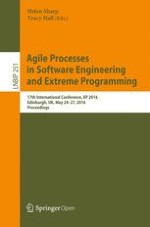This book contains the refereed proceedings of the 17th International Conference on Agile Software Development, XP 2016, held in Edinburgh, UK, in May 2016.
While agile development has already become mainstream in industry, this field is still constantly evolving and continues to spur an enormous interest both in industry and academia. To this end, the XP conference attracts a large number of software practitioners and researchers, providing a rare opportunity for interaction between the two communities.
The 14 full papers accepted for XP 2016 were selected from 42 submissions. Additionally, 11 experience reports (from 25 submissions) 5 empirical studies (out of 12 submitted) and 5 doctoral papers (from 6 papers submitted) were selected, and in each case the authors were shepherded by an experienced researcher. Generally, all of the submitted papers went through a rigorous peer-review process.
